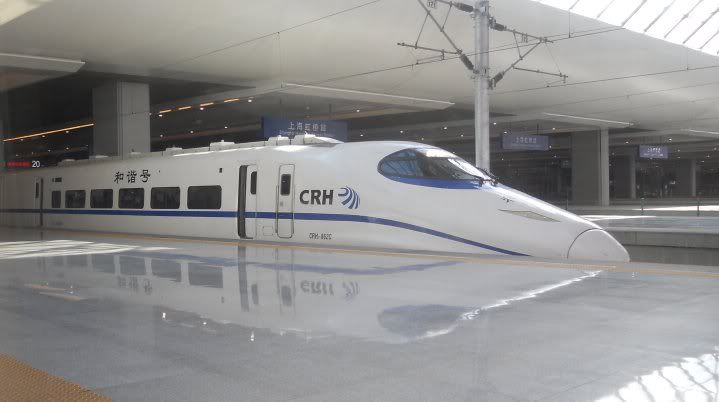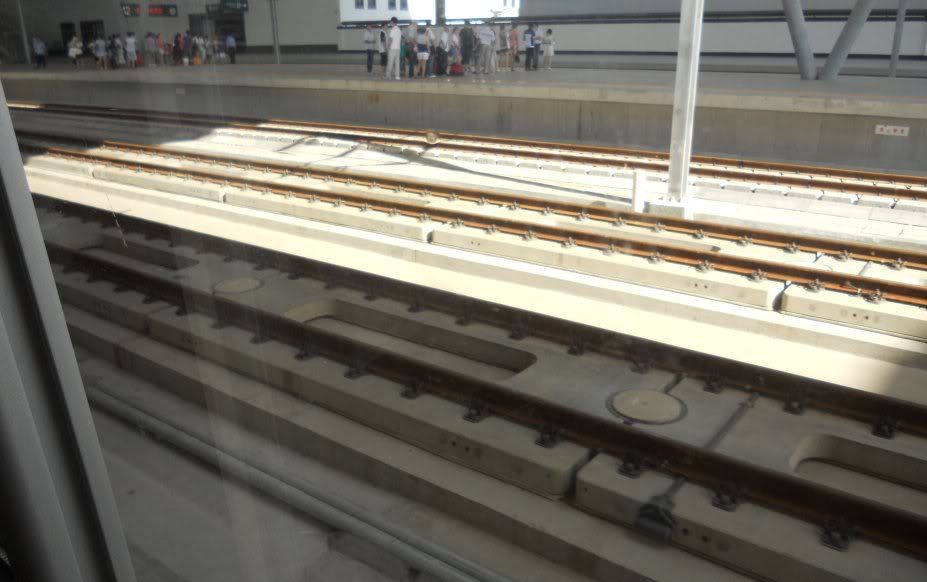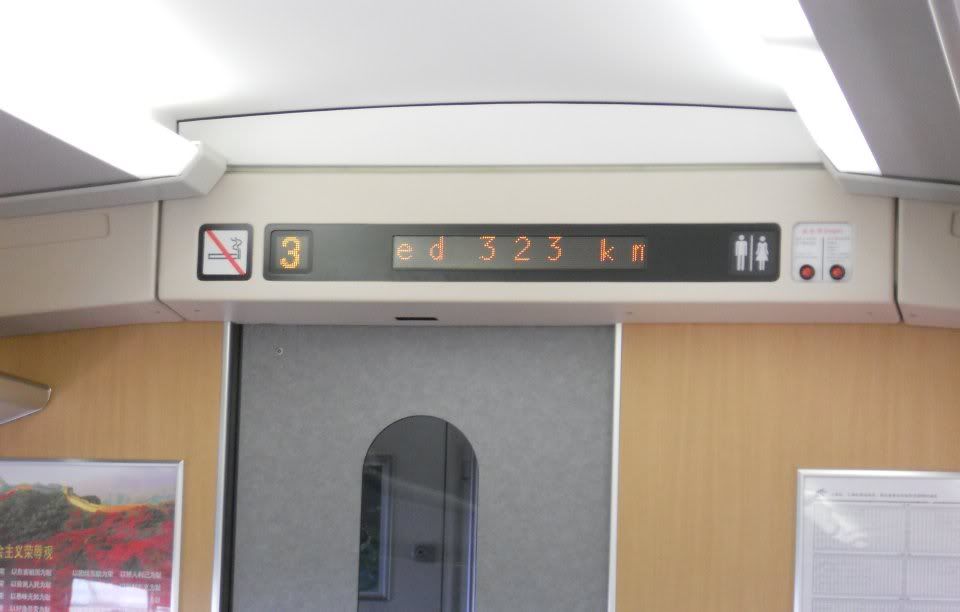
Posted on 07/25/2010 6:38:48 PM PDT by PugetSoundSoldier
There's a big push in some corners of the US transportation industry to "bring high speed rail to America". Visions of relaxed, latte-sipping trips over the nation, no lines for security, low cost trips are certainly heady ideas, but do they bear out? Let's take a critical, cold, calculating look at the reality of the situation.
As many know, I split my time between the US (Seattle, WA area) and Asia (predominantly Shanghai, China). China's been on a high speed rail building frenzy recently, and there are thousands of kilometers of line laid, with thousands more to come. Soon most of the larger Chinese cities in the East will be connected by high speed rail.
Just yesterday I rode one of these new marvels: the high speed rail line from Shanghai Hong Qiao (a behemoth of a transportation hub, consisting of an airport with two, 3400 meter runways, a bus terminal, a rail terminal, and a subway station) to Suzhou, a small town (well, by Chinese standards: only 6 million people) about 130 km away.
Hong Qiao is massive, even by Chinese standards. Not only are there 75 airline gates, but 36 long distance bus slots, 16 rail platforms, eight taxi stands (each capable of handling 800+ taxis at a time) and a full-size subway terminal. Soaring ceilings and highly polished marble and granite floors abound, and there is a good amount of space as befits China's 4th busiest airport/transportation terminal.
What does one of these new trains look like? Sleek and streamlined, as you would expect from a train capable of 300+ kilometers per hour:

These speedsters ride on some pretty specialized and dedicated rail lines, as you would expect:

Heavily bedded, full-length concrete foundations, and track ties every 20 cm. Absolute rigidity and stability is required for a train capable of such high speeds. And they do move right along:

Yes, that's 323 kilometers per hour, a hair over 200 miles per hour. It's no slouch in terms of speed! Fast, clean, relatively spacious transportation. And the ticket price of 41 RMB each way (about $6 USD) is quite cheap, too - nearly as cheap as the old, slower rail lines (which, at 26 RMB are a good discount, but take 50 minutes to cover the same distance we sped across in just 20 minutes).
So why do I say that high speed rail will not work in the US? One word:
Ridership
You see, I rode train G7130, which departed Hong Qiao on Sunday morning at 7:51 AM. And I rode train G7273 back on Sunday evening, which left Suzhou at 7:18 PM. And in each case, EVERY seat was taken, and it was standing-room-only at the ends of the cars.
Sixteen cars per train. Eighty five seats per car. And another 15-20 people standing in the baggage areas of each car. Over 1600 passengers on each train.
And there are 70 such trains a day between Suzhou and Hong Qiao. And every single one is full. Do the math - that is 112,000 riders per day on a single, 20 minute ride. And it's like that 7 days a week (remember, I rode on a Sunday and still had to buy my tickets a day in advance to guarantee a seat).
Close to 800,000 riders a week. Over 40 million a year on a single line. That's 25% more than rode ALL of Amtrak last year. And this is just a single line (not even the busiest - that title is reserved for Beijing to Tianjin, and Guangzhou to Shenzhen).
There are no discounts in China; you pay the full fare, no free tickets. That's $672,000 per day in revenue on that single train.
I talked a bit with with Wang Xiaoyan, the director of G7130 as we sped through the city. In her trademark skirt, black shoes, neatly pressed blouse, buttoned vest, and cap (with the proudly displayed "director" arm band), she provided a few details to this gao da lao wai (big and large foreigner):
China spent 23 billion RMB (about $3.4 billion USD) to deploy this stretch of track. With ridership of 35 million per year, and operating costs of 32 RMB per passenger, China expects to recover its investment in about 10 years, when the tracks need to be reworked (every 8-15 years you need to rebed and replace the tracks, to account for settling and shifting of the line).
In other words, China's doing this not because they have billions of people to move (which they do), but because it will not be an economic drain on the economy. It will cover its own costs, including maintenance.
Additionally, the construction costs are amazingly low - only $45 million per mile. Thanks to the cheap labor costs in China, and the incredibly flat terrain (Hong Qiao is at 3 meters elevation above sea level; Suzhou is at 5 meters - less than 7 feet difference, and it's completely flat between the two locations) China can build the rail for a low cost.
Consider the recent London-to-Edinburgh high speed rail line - $55 billion for 534 kilometers (note: the distance from London to Edinburgh is 331 miles, but the plan requires 1500 miles of line to make that distance a reality; you need to deploy more than just the lineal distance between locations). That's $166 million per mile, about 4 times the cost of that in China. Deploying high speed rail in the US will be much closer to the prices seen in the UK as compared to those in China, especially when you start to factor in the montainous and varied terrain in the US, as compared to most of Eastern China (and as a point of reference, Seattle's recent Link Light Rail had a cost of $179 million per mile, in line with the UK costs of deployment).
Given the plan for a 17,000 mile (27,000 kilometer) network in the US, we would see costs of $2.8 TRILLION to deploy this network (at UK line prices). A massive outlay of cash, orders of magnitude larger than that planned by China for its entire network (which already is the largest in the world, and growing rapidly).
And ridership will be lower, as well. Consider that a single segment of one line inside China eclipses all rail riders in the US. If we assumed that US ridership would increase by a factor of 10 - 300 million riders a year - and that the lines had a 25 year lifespan before being replaced (about twice what is realistic), we'd see that the per-rider capital costs alone would be $376 per trip. And this assumes 0% cost of money (interest free loans/bonds issued). No financing costs, and a 20X factor in the use of the line and we're still at close to $400 per rider per day in subsidies.
This does not include operating costs, either. Three Hundred Seventy Six dollars PER TRIP. Each of those 300 million trips each year, with a $376 subsidy tacked on.
When you run the numbers, it becomes painfully obvious why high speed rail should be shunned in the US - it simply does not make sense. We have too few people spread over too large an area, with too high of a deployment cost to make this anywhere near a reasonable approach to transportation in the US. It may make sense for a select few tiny lines (the famed NE corridor, for example), but as a realistic national network? The numbers just don't add up.
“That’s all there was then, and this is what it would take to pack the trains - the elimination of all other forms of transportation. “
That may be the key, if BO gets his wish and jacks oil up to $8 a gallon.
Eminent domain. Problem solved.
You missed the point entirely.
We have nearly 3 CENTURIES of 100% of our petroleum needs (including fuel) right within the Continental US.
Shale Oil and Tar Sands are very low quality petroleum deposits that require much more difficult and expensive methods of extraction than traditional oil. The simple fact that you have to hype them as some bogus indicator of bountiful petroleum based energy is evidence that depletion of traditional oil resources and Peak Oil theory is real.
Please read my post, follow the references. You’ll see it’s documented to be economical at $20-$25 per barrel. Exxon, RAND, and others make the case with actual science and facts.
But you’re the master of lack-of-facts, just stating something and leaving it at that. Peak oil is a myth, high speed rail is WAY too expensive for the US to consider.
Go ahead, Willie - how about justifying a $376 per TRIP subsidy. Or show me where my numbers are wrong. Put some facts down on paper, prove your case. Or simply be shown - once again - to be an empty-headed shill for trains.
Dipstick.
Virtually everyone on FR can add except you. Any plans for acquiring that skill?
Well, we'll see. Meantime, due at minimum to your economic incompetence, why not apply for a job with your HE-E-E-RO, Zerobama?
As a long-term conservative investor, I don't take investment advice from some day-trading conartist who practices "market timing". It is foolish to assume that past market performance is a predictor of future market trends. Unfortunately, there are many gullible people who are suckers for that "easy money" crap, just like they think they can anaylze the statistics to "beat the odds" in Vegas.
Wise investors would be much better off adhering to the fundamental principles of value investing than falling for that "market timing" crap.
Everything ‘works’, but at what cost/price?
Willie Green and other leftists, union and contractor hack greedheads want trains, as the road builders are pretty competitive, so there is not much industry growth.
Heck, I next suppose Willie, the unions, contractors and hack politicians will be wanting barge canal nationwide.
Imagine the profits fro shearing the sheeple!
Will confronted with facts deeper than the first page of a lefty ‘intermodal’ site, Willie just does a Judy Garland, clinks his heels and moves on with his little train, Toto.
This is for a family of 4 right?
And it is a good thing that the train picks you up at your front door so you don't have to drive downtown to the station and park your car.
And if the whole family has a SunPass tattooed on their foreheads then the trip goes much quicker and you never see the money fly out of your hands.
Please read my post, follow the references. You’ll see it’s documented to be economical at $20-$25 per barrel. Exxon, RAND, and others make the case with actual science and facts.
The RAND study you cite actually says "US$70–95 adjusted to 2005 values", but serves as an illustration to others as how you cherry-pick information and then play a mix & match shell game with the data to misrepresent the facts.
Talk about cherry picking! You pick on the first 0.025% of all the oil pumped and claim that is the fixed price. You're a piece of work, Willie - about as brazen a shyster and liar as I've seen! And one who never even posts a fact - ever. Just slams others and ignores the truth staring him in the face.
So how about the $376 PER TRIP subsidy, Willie? Gonna claim that's a lie, too? I did the math, the references are there. You lie about oil because you have some twisted vendetta created by some supposed "wrong" that "Big Oil" committed against you in the past. So you've become completely obsessed and irrational.
Go ahead, Willie. Justify the subsidy. Lay it out there. Or do your usual "it's a lie" and leave without any backing. Showing you for the empty headed drivel writer you are...
Way to lie about me, Willie... It STARTS at $70 per barrel but quickly falls down to $30 per RAND. And there are other methods that drop below $20 per barrel.
Those are marginal operating costs and do not include the massive investment required to develop the shale oil / tar sand infrastructure.
Nevertheless, it really doesn't matter.
I never said that Peak Oil would make shale oil and tar sands unprofitable.
Quite the opposite.
I expect that the market price of oil (as determined by supply and demand) will greatly exceed the costs of production. But the problem remains... we simply won't be capable of processing it fast enough to satisfy demand. Shortages will occur and prices will skyrocket.
And so will ridership on passenger rail systems.
Doubtless I shall now get a lecture from you on why arbing vols is an unsatisfactory investment technique, notwithstanding of course that you haven't the first clue as to what is involved in such arbitrage.
“just not gub’mint run boondoggle passenger trains.”
Guess I’d have to agree with ya
With over 400 years of US supply in California reserves there isn’t any such thing as Peak Oil!
Peak Oil only exists in the minds of socialists and choo-choo Willie!
Yes that would be for a family of four. 4 x $30 to get to Disney plus 4 x $30 to get home. Plus parking in Tampa.
And it only makes sense for those people in downtown Tampa or West since the folks on the east side of Tampa can hit Disney in about 45 minutes anyway.
Doesn’t make any sense.
You display your ignorance yet once more. I am almost exclusively a volatility arbitrageur, not a "market timer"."
Volatility arbitrage = Day trader
I was right.
"Volatility arbitrage" is an ultra-myopic investment gambling technique that is void of any long term fundamental market analysis.
IOW, your opinion on Peak Oil ain't worth poop.
Willie, the train from Tampa to Orlando has an initial investment of $1.5 Billion and most people think it will take at least $3 Billion to get it built.
At a $30 ticket per person it will take 100 million tickets to pay off the cost not including the operating expenses. At $30 a ticket its cheaper to drive or rent a car.
Even assuming they can build it for the $1.5 it would still require 50 million tickets to be sold. Lets give them a generous 500 passengers per trip, it will take 100,000 trips to pay off the cost. At 8 trips per day it will take them 34 years to recoup that investment.
But we know nobody will pay $30 a ticket so it will never get paid off. Passenger rail does not make sense in low population density areas.
Arbing vol in options is: 1) very distinctly NOT a daytrading strategy; the typical trade has a duration of 5-6 weeks, 2) there is very little or (ideally) no "gambling" involved; the strategy is pendent on locating options that are demonstrably mispriced and whose price(s) will revert to close to fair value as expiration nears, and 3) if done carefully, a vol-arb portfolio will actually have a lower beta than the broad market.
I "gamble" a WHOLE lot less than almost anyone who simply owns shares.
Volatility, dear boy, in the investment sense of the word, is a statistical measure, no more, no less. It has effectively nothing to do with how 'wild' a market or markets are, or with daytrading or "market timing".
And it most certainly has nothing to do with "peak oil"; I'll let you economic and energy-business illiterate types deal with that non-concept. Just in passing, there is more crude-equivalent kerogen in the Green River shales (and that's just one area) than in the entirety of Saudi Arabia and Iran combined. And we know how to extract it for roughly $42-46/bbl-equivalent.
Peak oil, is it? A myth, just like the notion of light-rail passenger trains being anything but a gigantic long-term money pit for taxpayers.
Don't start with me on economic issues, Willie. I deal with them in the real world all day, every day, and have for decades. Which, of course, it is so easy to identify an economic illiterate when one such as you turns up. All you know how to do is call names...all of which, in this particular correspondence, have been grossly inaccurate in fact.
Do have a nice day. I'm off to make some more profit.
But we know nobody will pay $30 a ticket so it will never get paid off.
Your faulty analysis falsely assumes that the long term value of infrastructure assets depreciate to zero, when in reality, they will appreciate in value if properly maintained.
Furthermore, the regional economic benefits transcend what is collected as train fare. Communities serviced by Amtrak also enjoy increased economic growth that the service provides.
Passenger rail does not make sense in low population density areas.
The Tampa Bay Area is the 19th most populous region in the United States with 2,747,272 people.
The Orlando area is 27th with 2,082,421 people.
Those are NOT "low population density areas."
Disclaimer: Opinions posted on Free Republic are those of the individual posters and do not necessarily represent the opinion of Free Republic or its management. All materials posted herein are protected by copyright law and the exemption for fair use of copyrighted works.